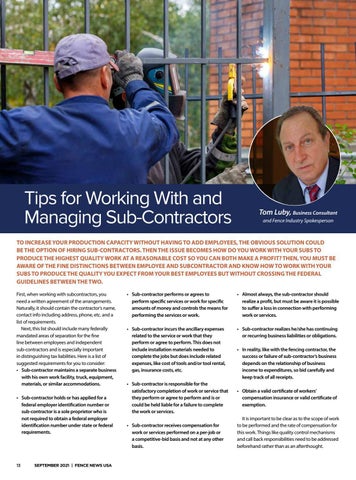Tips for Working With and Managing Sub-Contractors
Tom Luby, Business Consultant and Fence Industry Spokesperson
TO INCREASE YOUR PRODUCTION CAPACITY WITHOUT HAVING TO ADD EMPLOYEES, THE OBVIOUS SOLUTION COULD BE THE OPTION OF HIRING SUB-CONTRACTORS. THEN THE ISSUE BECOMES HOW DO YOU WORK WITH YOUR SUBS TO PRODUCE THE HIGHEST QUALITY WORK AT A REASONABLE COST SO YOU CAN BOTH MAKE A PROFIT? THEN, YOU MUST BE AWARE OF THE FINE DISTINCTIONS BETWEEN EMPLOYEE AND SUBCONTRACTOR AND KNOW HOW TO WORK WITH YOUR SUBS TO PRODUCE THE QUALITY YOU EXPECT FROM YOUR BEST EMPLOYEES BUT WITHOUT CROSSING THE FEDERAL GUIDELINES BETWEEN THE TWO. First, when working with subcontractors, you need a written agreement of the arrangements. Naturally, it should contain the contractor’s name, contact info including address, phone, etc. and a list of requirements. Next, this list should include many federally mandated areas of separation for the fine line between employees and independent sub-contractors and is especially important in distinguishing tax liabilities. Here is a list of suggested requirements for you to consider: • Sub-contractor maintains a separate business with his own work facility, truck, equipment, materials, or similar accommodations. • Sub-contractor holds or has applied for a federal employer identification number or sub-contractor is a sole proprietor who is not required to obtain a federal employer identification number under state or federal requirements.
13
SEPTEMBER 2021 | FENCE NEWS USA
• Sub-contractor performs or agrees to perform specific services or work for specific amounts of money and controls the means for performing the services or work.
• Almost always, the sub-contractor should realize a profit, but must be aware it is possible to suffer a loss in connection with performing work or services.
• Sub-contractor incurs the ancillary expenses related to the service or work that they perform or agree to perform. This does not include installation materials needed to complete the jobs but does include related expenses, like cost of tools and/or tool rental, gas, insurance costs, etc.
• Sub-contractor realizes he/she has continuing or recurring business liabilities or obligations.
• Sub-contractor is responsible for the satisfactory completion of work or service that they perform or agree to perform and is or could be held liable for a failure to complete the work or services. • Sub-contractor receives compensation for work or services performed on a per-job or a competitive-bid basis and not at any other basis.
• In reality, like with the fencing contractor, the success or failure of sub-contractor’s business depends on the relationship of business income to expenditures, so bid carefully and keep track of all receipts. • Obtain a valid certificate of workers’ compensation insurance or valid certificate of exemption. It is important to be clear as to the scope of work to be performed and the rate of compensation for this work. Things like quality control mechanisms and call back responsibilities need to be addressed beforehand rather than as an afterthought.














